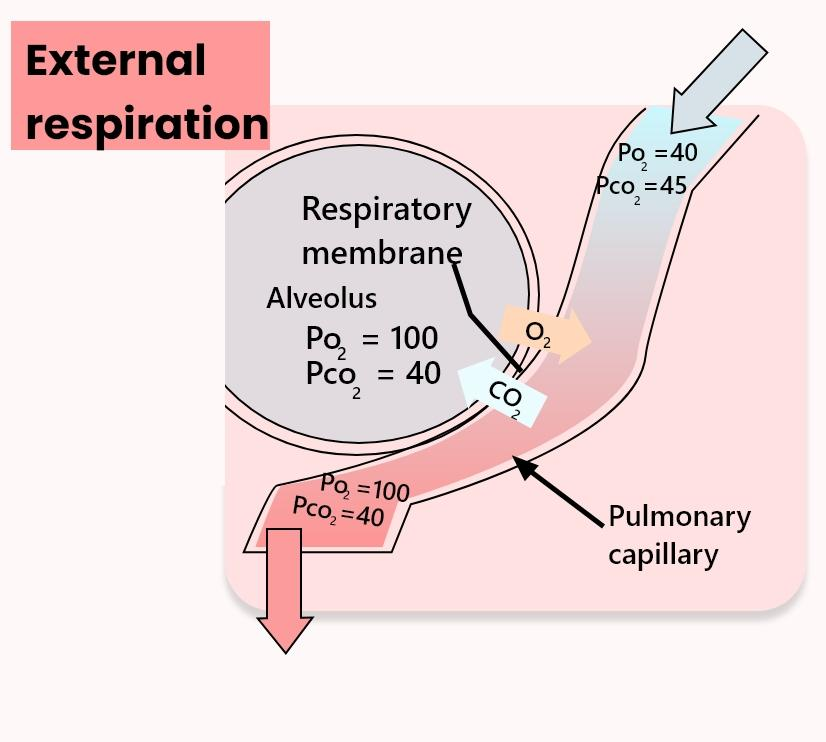
When oxygen diffuses into the blood and carbon dioxide diffuses into the alveolar air is called
(a) Internal inspiration
(b) Anaerobic respiration
(c) External respiration
(d) None of the above
Answer
561.3k+ views
Hint: It describes the exchange of gasses between the external environment and the bloodstream. The partial pressure gradients permit the gasses to flow from areas of high pressure to areas of lower pressure. For maintaining the efficient gas exchange the ventilation and perfusion in alveoli must be balanced.
Complete step by step answer:
In general, there are two types of respiration, internal and external respiration. The gaseous exchange during external respiration occurs through the respiratory membrane in the lungs. The gas exchange takes place between the alveoli and the blood in which there is the diffusion of the oxygen from the alveoli to the blood and carbon dioxide from the blood to the alveoli. In internal respiration, gas exchange between the capillaries and the cells of metabolizing tissues.
So, the right answer is ‘External respiration’.
Additional information: The essential three parts of external respiration are the surface area of the alveolar membrane, the partial pressure gradients of the gasses, and the matching of perfusion and ventilation.

Surface Area
The alveoli have a very high surface area to the volume proportion that is considered for efficient gas exchange. The alveoli are secured with a high density of capillaries that give numerous destinations to gas exchange.
Partial Pressure Gradients
The partial pressure gradients (differences in partial pressure) permit the loading of oxygen into the bloodstream and the emptying of carbon dioxide out of the bloodstream. These two processes occur at the same time.
Ventilation and Perfusion Matching
The exchange of gas and blood supply to the lungs must be adjusted so as to encourage proficient external respiration. While an extreme ventilation-perfusion bungle demonstrates serious lung disease, minor irregular characteristics can be amended by keeping airflow that is corresponding to capillary blood flow, which keeps the balance of ventilation and perfusion.
Note: The partial pressure gradient of oxygen about 60 mmHg (100 mmHg in alveolar air and 40 mmHg in deoxygenated blood ) and it diffuses rapidly from the alveolar air into the capillary. The equilibrium between the alveolar air and capillaries is reached rapidly, inside the primary third of the length of the capillary within a third of a second. The partial pressure of oxygen in the oxygenated blood is about 100 mmHg of the capillary after oxygen loading.
Complete step by step answer:
In general, there are two types of respiration, internal and external respiration. The gaseous exchange during external respiration occurs through the respiratory membrane in the lungs. The gas exchange takes place between the alveoli and the blood in which there is the diffusion of the oxygen from the alveoli to the blood and carbon dioxide from the blood to the alveoli. In internal respiration, gas exchange between the capillaries and the cells of metabolizing tissues.
So, the right answer is ‘External respiration’.
Additional information: The essential three parts of external respiration are the surface area of the alveolar membrane, the partial pressure gradients of the gasses, and the matching of perfusion and ventilation.

Surface Area
The alveoli have a very high surface area to the volume proportion that is considered for efficient gas exchange. The alveoli are secured with a high density of capillaries that give numerous destinations to gas exchange.
Partial Pressure Gradients
The partial pressure gradients (differences in partial pressure) permit the loading of oxygen into the bloodstream and the emptying of carbon dioxide out of the bloodstream. These two processes occur at the same time.
Ventilation and Perfusion Matching
The exchange of gas and blood supply to the lungs must be adjusted so as to encourage proficient external respiration. While an extreme ventilation-perfusion bungle demonstrates serious lung disease, minor irregular characteristics can be amended by keeping airflow that is corresponding to capillary blood flow, which keeps the balance of ventilation and perfusion.
Note: The partial pressure gradient of oxygen about 60 mmHg (100 mmHg in alveolar air and 40 mmHg in deoxygenated blood ) and it diffuses rapidly from the alveolar air into the capillary. The equilibrium between the alveolar air and capillaries is reached rapidly, inside the primary third of the length of the capillary within a third of a second. The partial pressure of oxygen in the oxygenated blood is about 100 mmHg of the capillary after oxygen loading.
Recently Updated Pages
Master Class 12 Business Studies: Engaging Questions & Answers for Success

Master Class 12 Economics: Engaging Questions & Answers for Success

Master Class 12 English: Engaging Questions & Answers for Success

Master Class 12 Maths: Engaging Questions & Answers for Success

Master Class 12 Social Science: Engaging Questions & Answers for Success

Master Class 12 Chemistry: Engaging Questions & Answers for Success

Trending doubts
What is meant by exothermic and endothermic reactions class 11 chemistry CBSE

Which animal has three hearts class 11 biology CBSE

10 examples of friction in our daily life

One Metric ton is equal to kg A 10000 B 1000 C 100 class 11 physics CBSE

1 Quintal is equal to a 110 kg b 10 kg c 100kg d 1000 class 11 physics CBSE

Difference Between Prokaryotic Cells and Eukaryotic Cells




